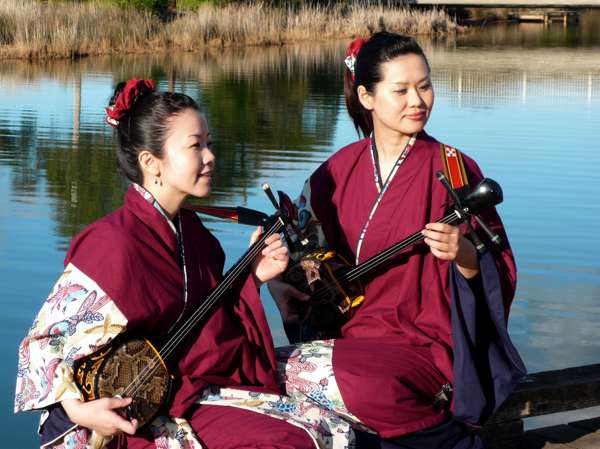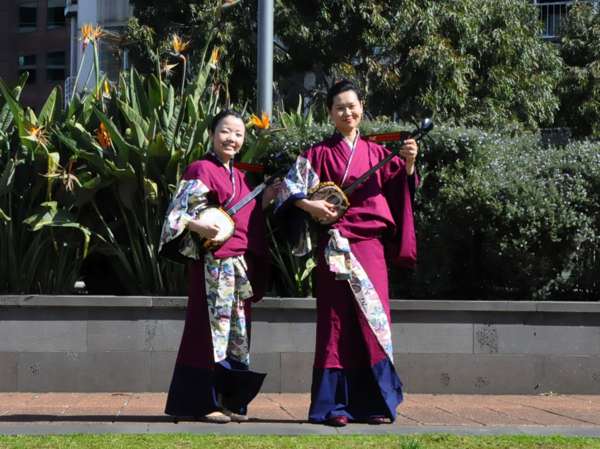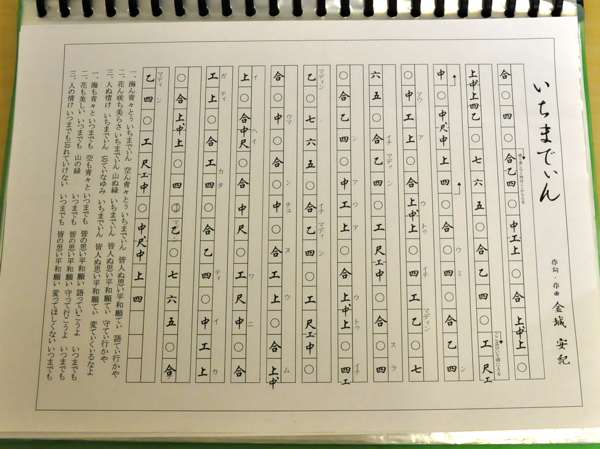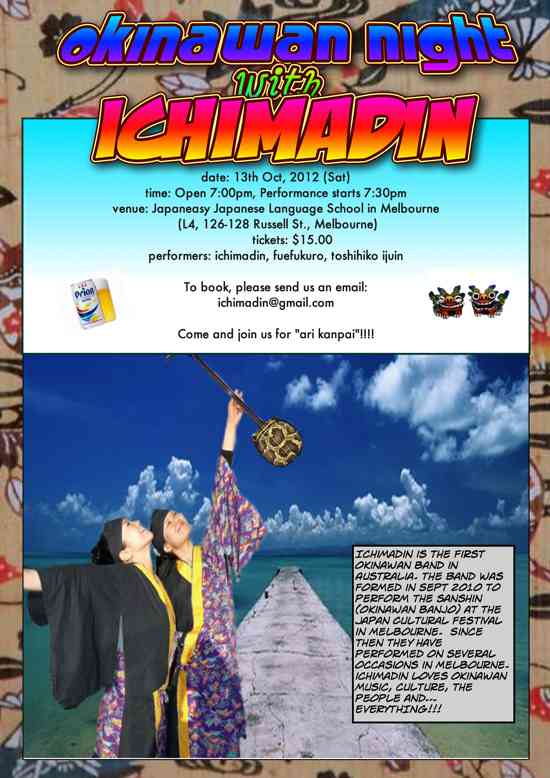Japanese – English
We recently interviewed the Okinawan Sanshin group Ichimadin for an upcoming concert event at Japaneasy Japanese Language School (Japaneasy) in Melbourne on the 13th of October. Sanshin is a traditional Okinawan string instrument but we didn’t know anything more about it before the interview.

Left: Chiemi Right: Junko
Ichimadin Profile (from their Facebook page)
Ichimadin was formed in 2010 SEPT. The group is possibly the very first sanshin group in Melbourne, or in Australia. Current members are Chiemi and Junko. We both love to sing songs to sanshin. The name of the group, Ichimadin, means “forever” in okinawan dialect. Ichimadin would love to share the beautiful sound of sanshin together with you. Moreover, Chiemi is a talented Koto player. You must see her play!!!!!! You might get a chance to see her play koto when ichimadin has a gig!!!
What is “Sanshin”?
Interviewer (I): Although I am a native Japanese, I don’t know much about the “sanshin.” I’ve heard that is something like the shamisen, a traditional Japanese three-string instrument.
Chiemi (C): People might consider sanshin as a by-product of shamisen, which is one of the most popular traditional instruments in Japan. But the history of sanshin is actually older than that of the shamisen.
Junko (J): The word “shamisen” used to refer to the sanshin of Okinawa. The instrument was introduced from Okinawa to Osaka, where it developed into the modern Japanese shamisen. For the purpose of differentiation, people started to call the one in Okinawa “sanshin.” That’s why Okinawans still call the sanshin “shamisen.”
I: What is the difference between these two instruments?
C: The sanshin of Okinawa is covered with python snakeskin. On the other hand, the shamisen of the mainland is covered with cat skin simply because snakeskin was hard to obtain in the mainland Japan. Of course, different materials produce different sounds.
J: I think that each sound reminds me of where they come from. The sound of sanshin gives me an impression of the relaxed atmosphere of the southern island whereas shamisen gives me an impression of the rough Sea of Japan.
I: But why the sanshin? Why did you start playing it?
C:
I listened to Okinawan music for the first time when I was in middle school. I fell in love with it and that made me want to visit Okinawa. In high school we had a school trip to the island. Actually I chose this high school because I really wanted to go there…I started playing the sanshin to build excitement in preparation for the trip to Okinawa.
I: A school trip? I thought you are from Okinawa.
J:
No. I’m from Osaka and Chiemi’s from Hiroshima. We made a trip to Okinawa a few times before but that’s all. I’ve always liked Okinawan artists like Rimi Natsukawa who has introduced me a various kinds of Okinawan songs. I am also strongly attracted by the Okinawan atmosphere, which made me feel at home. People get together like family and enjoy drinking, singing, and dancing to the sound of sanshin. I personally think that is the Okinawan spirit.

How We Got Together as Ichimadin
J: I stopped playing the sanshin when I came to Melbourne. My sanshin had been untouched for a long time, and I thought that would be a shame to leave it like that. So I thought I have go to start playing it again, hopefully together with someone. I posted a message online asking if anyone would like to play sanshin with me. That is how I met Kohei, who unfortunately had to return to Japan.
C: I played the sanshin in public for the first time in Melbourne at the Christmas event hosted by Japaneasy. In the following year, I was introduced to Kohei, and through Kohei, I met Junko. That was how we met and started to play sanshin together, and…
J: That was how we started “Ichimadin”.
I: It is apparent that there arn’t many people who play such a rare insturument here in Melbourne, and so probably that was why it was hard for you to find someone who plays sanshin.
C: Sanshin is actually not a rare instrument. It has became popular in Japan through an Okinawan drama series “Churasan”, which aired on national broadcast in 2001. It is taught in many local areas, and played by many people these days.
I: What do you do apart from playing the sanshin?
C: We teach Japanese at Secondary Schools in Victoria. I left Japan when I married to an Australian, but it was hard for me to leave the country I love. The sanshin has supported me since then.
J: Chiemi has many years of experience as a Japanese teacher and a sanshin player. I graduated from Monash University last year and recently started my career as a Japanese teacher this year. I am learning a lot from her as a teacher as well as a sanshin player.
Our Past, Present, and Future
I: Can you tell us about what ichimadin has been doing for the past few years since 2010?
C: We have started receiving offers from the people and organizations. They saw us performing at a cultural festival held by Japaneasy in 2010. The most recent concert that we were invited to was held by Wadaiko Rindo.
J: We were also invited to a Japanese Festival. We try to perform at as many places as possible. We have been busier this year as we’ve given more opportunities to perform.
C: We also teach sanshin twice a month.
I: What do your students think of the lesson?
C: They seem to enjoy the lessons. It is definitely hard to begin with a traditional Okinawan song, so we choose an English song familiar to anyone, such as “Twinkle Twinkle Little Star.”
J: Although the other traditional Japanese instruments seem too elaborate and difficult to play, Sanshin is actually easy.
C: Yeah. Its music note (kun kun shii) is quite different from the one we’re familiar with (please see the photo), and people often believe that it must be difficult. But everyone says it is actually easy onece you get used to reading kun kun shii.

The Message We Want to Send through Our Sanshin Music
J: There is an Old Okinawan saying “Ichariba Choodee” which means “once we meet, we are like brothers and sisters”. That’s exactly what we want the audience to feel from our music. We want them not only to listen to our music, but also to thoroughly enjoy the togetherness. We usually asked the audience to dance in the concerts.
I: Does everyone dance without hesitation?
C: Everyone enjoys dancing. As we perform we usually give a quick dancing lesson so they can get to learn how to dance beforehand.
I: What are you going to play at the concert in October?
C:
We’ll start from slow songs such as “Tinsagu nu Hana” and “Asadoya Yunta” for a warm-up, then more rhythmical ones to get everyone to dance.
I: Tinsagu…?
J: It means Rose Balsam blossom.
I: Would you play them for me as I have no idea what is the song like?
C&J: Now!?
I: Thank you very much for your great performance. I don’t know much about the music, but somehow it sounded so familiar to me. It touches my heart.
C: I think so too. I hope our music provides all the Japanese living in Melbourne with opportunities to remember their home land and loved ones.
J: It also would be wonderful if our music makes Australians be interested in Japan as I teach Japanese
in regional Victoria where people have less interest in our culture.
A Message to the JIM and GO Readers
C: As we mentioned before, we are going to have a gig at Japaneasy from 7pm on 13th October.
We have guest musicians performing with us. They are FUEFUKURO (wadaiko and shinobue) and Toshihiko Ijuin (guitarist). We look forward to seeing you all there, and let’s have an Okinawan style party!!!
J: You will see us in traditional Okinawan looking outfits made by Chiemi.
C: Please visit us on our Facebook page for more information.
I: Do you have anything else you want to say to the readers?
J: I wonder if someone will open the first Okinawan restaurant in Melbourne. LOL
C: Somebody please open the Okinawan restaurant! We will play the sanshin for free! LOL
I: I hope that you will continue your musical career for many years to come as “Ichimadin” means “forever” in Okinawan language.
Okinawan Night with Ichimadin
Date:13th Oct 2012(Sat)
Time:Open 7:00pm Performance starts 7:30pm
Venue:Japaneasy (L4 126-128 Russell St., Melbourne)
Performers:Ichimadin, FUEFUKURO, Toshihiko Ijuin
Ticket:$15.00
To book:ichimadin@gmail.com
web:http://www.facebook.com/pages/Official-Ichimadin-Site/145400942174048?ref=ts

Story: Kaori Asakami
Photos & Movies: Iwao Sasaki


